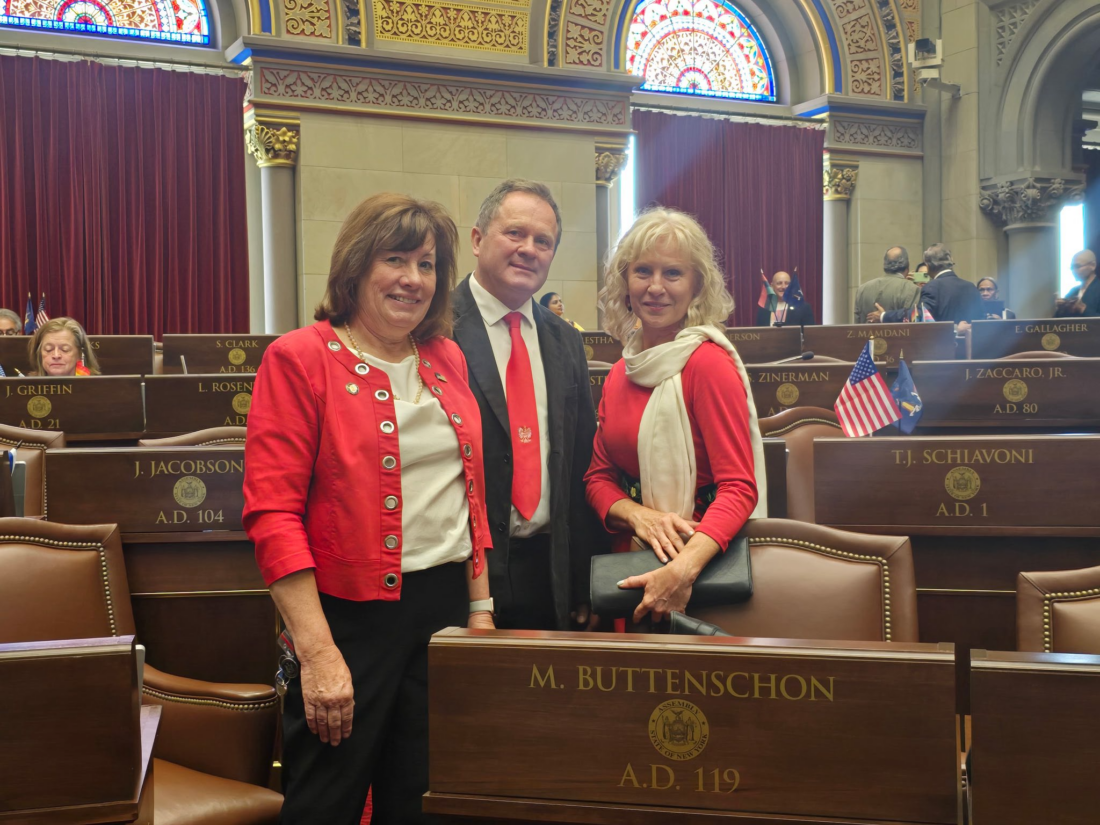Cleaner Change
New York State Lawmaker Proposes Dollars For Diesels

Assemblywoman Marianne Buttenschon, D-Utica, left, is pictured on the Assembly floor during a commemoration of Polish American heritage. Buttenschon is proposing a trade-in program similar to the 2009 federal Cash for Clunkers program that would involve only medium and heavy duty trucks.
We’ve had Cash for Clunkers. Now, a state lawmaker is proposing the Dollars for Diesels Act in an effort to encourage retirement of heavy and medium-duty vehicles older than 2010 model year trucks.
Assemblywoman Marianne Buttenschon, D-Utica, is proposing the retirement incentive program (A.8998) in an attempt to help drive older vehicles to the scrap yard and replace them with vehicles that emit less pollution. While Buttenschon says she would prefer to follow California’s push to replace diesels with zero-emissions vehicles, she said the charging infrastructure isn’t yet developed for that type of incentive program to work in New York.
“In order to meet state climate goals, NYS adopted California’s Advanced Clean Truck (ACT) regulation, which mandates that manufacturers of medium- and heavy- duty vehicles (M/HDVs) sell an increasing percentage of zero-emission vehicles (ZEVs) each year,” Buttenschon wrote in her legislative justification. “However, there are significant barriers to making this transition. There is currently no charging infrastructure in place for such vehicles, upfront costs of M/HD ZEVs are significantly higher than their diesel counterparts, the range for commercial M/HD ZEVs are significantly lower, and the added strain M/HD ZEVs would add to the electric grid would be unsustainable.”
The text of A.8998 leaves much of how the program would actually work to be developed by state agencies if the program is approved by the state Legislature. Incentives could include direct cash payments, grants or vouchers payable upon proof a vehicle is retired and replaced as specified by state officials. Incentives would come from existing state and federal money allocated to the state for diesel emissions reductions and clean transportation initiatives – though there is no dollar amount included in the bill text that would be set aside. That would be left to state agencies. Buttenschon said state DMV statistics show a third of the state’s medium and heavy duty trucks are model year 2010 or older.
“Retiring and replacing older models would have a meaningful impact on reducing emissions in the transportation sector,” Buttenschon wrote.
Retiring older trucks could boost orders for companies like Cummins, which is dealing with a slowdown in medium and heavy duty truck orders. Mark Smith, Cummins chief financial officer, and Jennifer Rumsey, Cummins president and CEO, told investor analysts during a conference call earlier this month that North American heavy and medium-duty truck volume is expected to decline 25% to 30% from second quarter levels. Truck orders are already at multi-year lows, Smith said, and companies that make parts for Cummins have begun limited work weeks that are expected to last the next three months. The Jamestown Engine Plant is affected by the decreased demand for heavy-duty truck engines.
Engine Segment sales came in at $2.9 billion in the second quarter of 2025, an 8% decrease from the second quarter in 2024 while the segment’s EBITDA totaled $400 million, or 13.8% of sales, compared to $445 million, or 14.1% of sales in the second quarter of 2024. Revenues decreased 8% in North America and 7% in international markets due to lower on-highway demand in the United States and Mexico.
“The duration of this reduced demand in North America truck markets will largely depend on the trajectory of the broader economy, the evolution of trade and tariff policies and the pace at which regulatory clarity emerges,” Smith said.
While Cummins and other vehicle manufacturers could benefit, the Cash for Clunkers program upon which Dollars for Diesels is based was shown not to have the broad impact that federal lawmakers had hoped to achieve with the 2009 incentive program. The most common deals under the government’s $3 billion federal Cash for Clunkers program, aimed at putting more fuel-efficient cars on the road, replaced old Ford or Chevrolet pickups with new ones that got only marginally better gas mileage, according to a 2009 analysis of federal data by The Associated Press.
The fuel economy for the new trucks ranged from 15 mpg to 17 mpg based on engine size and other factors, an improvement of just 1 mpg to 3 mpg over the clunkers.
The AP data obtained under the Freedom of Information Act analyzed 677,081 trade-ins under Cash for Clunkers. More than 95,000 of the new vehicles purchased under the program – or about one in seven – got less than 20 mpg, according to the data. The data show the average fuel economy was 15.8 mpg for the old vehicles and 24.9 for the new ones. But plenty of consumers bought relatively low-mileage trucks and SUVs with the help of government checks. In at least 145 cases, mostly involving trucks, the government reported consumers traded old vehicles that got better than or the same mileage as the new vehicle they purchased. In at least 15 deals in nine states, owners of large pickups cashed in old trucks for between $3,500 and $4,500 toward new Hummer H3 SUVs that got only 16 mpg. In at least 32 deals, drivers traded older vehicles for new large trucks – including versions of Toyota Tundras, GMC Sierras, Chevrolet Silverados, Dodge Rams and Ford F150 pickups – that got only 14 mpg. California led clunker sales with more than 76,000 trade-ins, followed by Texas with roughly 43,000 and New York with nearly 37,000.






